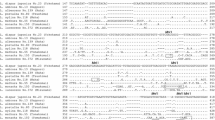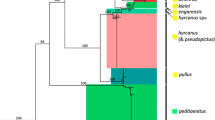Abstract
Anopheles (Cellia) annularis Van der Wulp is a complex of two sibling species provisionally designated as species A and B and can only be differentiated on the basis of the paracentric inversion in the ovarian polytene chromosomes. To analyze the distribution of these two species and to develop a molecular method for the identification of these two cryptic species, we sequenced the ribosomal DNA internal transcribed spacer 2 (ITS2) and domain 3 (D3) of A. annularis specimens collected from Sonapur (Assam), Jabalpur (Madhya Pradesh), Ranchi (Jharkhand), and Ghaziabad (Uttar Pradesh). We did not find any sequence variation among the specimens collected from Assam, Madhya Pradesh, and Jharkhand states, whereas two types of sequences were obtained from the specimens collected from the state of Uttar Pradesh, which correspond to species A and B of the A. annularis complex. Species A was more prevalent among the all four regions studied. The ITS2 sequence of species A showed unique restriction sites for MvaI and Eco24I, while species B displayed HinfI and NruI sites. Similarly, the D3 sequence of species A showed unique restriction site for Alw26I, while species B showed a unique KpnI site. In this study, we report for the first time the development of ribosomal DNA polymerase chain reaction-restriction fragment length polymorphism methods for identifying these two cryptic species of the Annularis complex.




Similar content being viewed by others
References
Alam MT, Das MK, Ansari MA, Sharma YD (2006a) Molecular identification of Anopheles (Cellia) sundaicus from the Andaman and Nicobar islands of India. Acta Trop 97:10–18
Alam MT, Das MK, Dev V, Ansari MA, Sharma YD (2006b) PCR-RFLP method for the identification of four members of the Anopheles annularis group of mosquitoes (Diptera: Culicidae. Trans R Soc Trop Med Hyg DOI:10.1016/j.trstmh.2006.03.007 (in press)
Atrie B, Subbarao SK, Pillai MKK, Rao SRV, Sharma VP (1999) Population cytogenetic evidence for sibling species in Anopheles annularis (Diptera: Culicidae). Ann Entomol Soc Am 92:243–249
Baimai V, Green CA, Andre RG, Harrison BA, Peyton EL (1984) Cytogenetic studies of some species complexes of Anopheles in Thailand and Southeast Asia. Southeast Asian J Trop Med Public Health 15:536–546
Bang YH (1985) Implication in the control of malaria vectors with insecticides in tropical countries of South East Asia. Part I. Insecticide resistance. J Commun Dis 17:199–218
Beebe NW, Saul A (1995) Discrimination of all members of the Anopheles punctulatus complex by polymerase chain reaction-restriction fragment length polymorphism analysis. Am J Trop Med Hyg 53:478–481
Chen B, Butlin RK, Pedro PM, Wang XZ, Harbach RE (2006) Molecular variation, systematics and distribution of the Anopheles fluviatilis complex in southern Asia. Med Vet Entomol 20:33–43
Collins FH, Paskewitz SM (1996) A review of the use of ribosomal DNA (rDNA) to differentiate among cryptic Anopheles species. Insect Mol Biol 5:1–9
Collins FH, Kamau L, Ranson HA, Vulule JM (2000) Molecular entomology and prospects for malaria control. Bull World Health Organ 78:1412–1423
Dash AP, Bendley MS, Das AK, Das M, Dwivedi SR (1982) Role of Anopheles annularis as a vector of malaria in Inland of Orissa. J Commun Dis 14:224
Dev V, Phookan S, Sharma VP, Anand SP (2004) Physiographic and entomologic risk factors of malaria in Assam, India. Am J Trop Med Hyg 71:451–456
Gao Q, Beebe NW, Cooper RD (2004) Molecular identification of the malaria vectors Anopheles anthropophagus and Anopheles sinensis (Diptera: Culicidae) in Central China using polymerase chain reaction and appraisal of their position within the Hyrcanus Group. J Med Entomol 41:5–11
Garros C, Koekemoer LL, Kamau L, Awolola TS, Van Bortel W, Coetzee M, Coosemans M, Manguin S (2004) Restriction fragment length polymorphism method for the identification of major African and Asian malaria vectors within the Anopheles funestus and An. minimus groups. Am J Trop Med Hyg 70:260–265
Ghosh KK, Chakraborty S, Bhattacharya S, Palit A, Tandon N, Hati AK (1985) Anopheles annularis as a vector of malaria in rural West Bengal. Indian J Malariol 22:65–69
Gunasekaran K, Sahu SS, Parida SK, Sadanandane C, Jambulingam P, Das PK (1989) Anopheline fauna of Koraput district, Orissa state with particular reference to transmission of malaria. Indian J Med Res 89:340–343
Koekemoer LL, Coetzee M, Hunt RH (1998) HpaII endonuclease distinguishes between two species in the Anopheles funestus group. Insect Mol Biol 7:273–277
Krzywinski J, Besansky NJ (2003) Molecular systematics of Anopheles: from subgenera to subpopulations. Annu Rev Entomol 48:111–139
Li C, Wilkerson RC (2005) Identification of Anopheles (Nyssorhynchus) albitarsis complex species (Diptera: Culicidae) using rDNA internal transcribed spacer 2-based polymerase chain reaction primes. Mem Inst Oswaldo Cruz 100:495–500
Litvaitis MK, Nunn G, Thomas WK, Kocher TD (1994) A molecular approach for the identification of Meiofaunal turbellarians (Platyhelminthes, Turbellaria). Mar Biol 120:437–442
Nagpal BN, Srivastava A, Saxena R, Ansari MA, Dash AP, Das SC (2005) Pictorial identification key for Indian anophelines. Malaria Research Centre (ICMR), Delhi, India
Narang SK, Seawright JA, Mitchell SE, Kaiser PE, Carlson DA (1993) Multiple-technique identification of sibling species of the Anopheles quadrimaculatus complex. J Am Mosq Control Assoc 9:463–464
Norris DE (2002) Genetic markers for study of the anopheline vectors of human malaria. Int J Parasitol 32:1607–1615
Prakash A, Bhattacharyya DR, Mohapatra PK, Mahanta J (2004) Role of the prevalent Anopheles species in the transmission of Plasmodium falciparum and P. vivax in Assam state, North-eastern India. Ann Trop Med Parasitol 98:559–568
Proft J, Maier WA, Kampen H (1999) Identification of six sibling species of the Anopheles maculipennis complex (Diptera: Culicidae) by polymerase chain reaction assay. Parasitol Res 85:837–843
Ramasamy R, De Alwis R, Wijesundere A, Ramasamy MS (1992) Malaria transmission at a new irrigation project in Sri Lanka: the emergence of Anopheles annularis as a major vector. Am J Trop Med Hyg 47:547–553
Rao TR (1984) The anophelines of India. Malaria Research Centre (Indian Council of Medical Research), New Delhi, India
Reid JA (1968) Anopheline mosquitoes of Malaya and Borneo. Stud Inst Med Res Malays 31:1–520
Shrestha SL (1985) Dynamics of malaria transmission with reference to development projects in Nepal. J Commun Dis 17:287–292
Subbarao SK (1998) Anopheline species complexes in Southeast Asia. WHO/SEA Tech Publ 18:81
Torres EP, Foley DH, Saul A (2000) Ribosomal DNA sequence markers differentiate two species of the Anopheles maculatus (Diptera: Culicidae) complex in the Philippines. J Med Entomol 37:933–937
Van Bortel W, Harbach RE, Trung HD, Roelants P, Backeljau T, Coosemans M (2001) Confirmation of Anopheles varuna in Vietnam previously misidentified and mistargeted as the malaria vector Anopheles minimus. Am J Trop Med Hyg 65:729–732
Wilkerson RC, Reinert JF, Li C (2004) Ribosomal DNA ITS2 sequences differentiate six species in the Anopheles crucians complex (Diptera: Culicidae). J Med Entomol 41:392–401
Acknowledgments
The authors would like to thank Prof. A. P. Dash [Director, National Institute of Malaria Research (ICMR), Delhi] for his support and Ms. Sumiti Vinayak for the discussion and for proofreading this manuscript. MTA acknowledges the Council of Scientific and Industrial Research for the Senior Research Fellowship. Financial support for the work granted by the Indian Council of Medical Research and the Department of Biotechnology, Government of India, is acknowledged. We are also grateful for the bioinformatics facilities of the Biotechnology Information System (BTIS). The authors also declare that the experiments performed in this manuscript comply with the current laws of India.
Author information
Authors and Affiliations
Corresponding author
Rights and permissions
About this article
Cite this article
Alam, M.T., Das, M.K., Dev, V. et al. Identification of two cryptic species in the Anopheles (Cellia) annularis complex using ribosomal DNA PCR-RFLP. Parasitol Res 100, 943–948 (2007). https://doi.org/10.1007/s00436-006-0375-9
Received:
Accepted:
Published:
Issue Date:
DOI: https://doi.org/10.1007/s00436-006-0375-9




